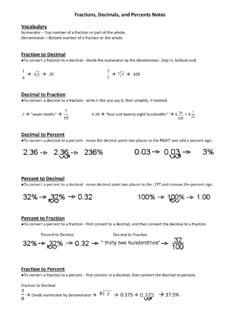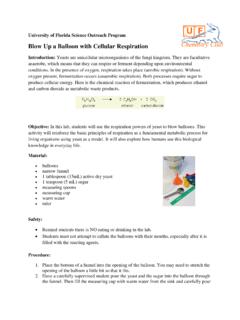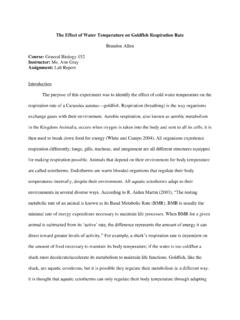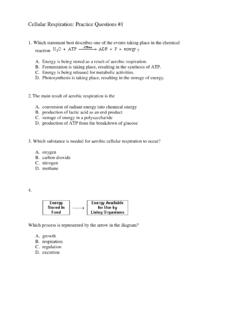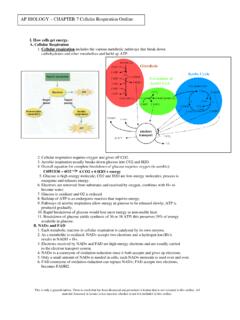Transcription of Cellular Respiration - Henry County Public Schools
1 Cellular RespirationCellular RespirationHave you ever wondered why exactly you need to breathe? What happens when you stop breathing? Cellular Respiration is the set of the metabolic reactions and processes that take place in the cells of all organisms to convert biochemical energy from nutrients into adenosine triphosphate (ATP cell energy), and then release waste FormulaC6H12O6+ 6O2-->6 CO2+ 6H2O + 36 ATPLook familiar?The best Respiration occurs in the presence of oxygen -called AEROBICW ithout oxygen, fermentation, oranaerobic Respiration , is used, but it s not as good(We ll come back to )There are three stages in Aerobic Respiration1.
2 Glycolysis2. Kreb'sCycle (aka Citric Acid Cycle)3. Electron Transport Chain and Oxidative Phosphorylation-net yield of 2 ATP and 2 NADH per glucose molecule (4 total produced ATP 2 used ATP = 2 net produced ATP)GLYCOLYSISGLYCOLYSIS = "glyco-lysis" is the splitting of a 6 carbon glucose into two 3-Carbon pyruvatescan occur without oxygen2. Citric Acid or Krebs Cyclea) occurs in the mitochondriab) an aerobic process; will proceed only in the presence of O2It is not necessary to know the individual steps-net yield of2 ATP, 6 NADH and 2 FADH2, which are all sent to ETCc) in this stage of Cellular Respiration , the oxidation of glucose to CO2is completed.
3 (this is why and when we exhale carbon dioxide)3. ETC and Ox Phos:a) consists of a series of enzymes on the inner mitochondrial membraneb) electrons are released from NADH and FADH2 and passed along a series of enzymes, giving up energy which is used to fuel chemiosmosisc) Makes ATP with ATP Synthetase(just like the ETC in Photosynthesis, just different names)c) Total net yield of 32-34 ATP per glucosed) 6 H2O are formed when the electrons unite with O2* at the end of electron transport chain.* Note: This is the function of oxygen in living organisms!Without oxygen to serve as the final electron acceptor, the process shuts this picture look familiar?
4 You've seen this before in of the ETCMcGraw Hill AnimationWhat about no oxygensituations?Anaerobic Respiration , AKA -FermentationTwo types of fermentation lactic acid (animals) and alcoholic (yeast/bacteria) Byproducts include lactic acidand alcohol-Note: Lactic Acid in muscle cells causes muscle happens when the Krebs cycle cannot occur due to lack of oxygen; purpose is to regenerate NAD+ so glycolysis can continueFermentation is used in making food products and alcohol are the 3 stages of Cellular Respiration ? for thought1. What is the purpose of Cellular Respiration ?2. Where does Cellular Respiration occur within the cell?3. What is the waste product of Cellular Respiration ?
5 Would you go to an oxygen bar?4. Compare Photosynthesis to Respirationa. Where does each occur?b. What are the products of each?c. What compounds are needed to start the processes?d. What is the function of the electron transport chain in each processe. Describe the role of ATPase in both Test1. In order to produce energy, cells start with glycolysis. If oxygen is NOT present afterglycolysis, what process occurs next?a) Electron Transport Chain b) Krebs Cycle c) Fermentation2. If oxygen IS present after glycolysis, what process occurs next?a) Electron Transport Chain b) Krebs Cycle c)Fermentation3. A process that does NOT require oxygen is known as what?
6 A) Aerobic b) Anaerobic4. In glycolysis, glucose is broken into 2 molecules of _____ acid5. Where does the Kreb's cycle occur? _____6. What gas is a waste product produced in the Krebs cycle? ____7. What enzyme is used in the electron transport chain to create ATP?a. citric acid b. pyruvate c. ATPase8. Where does glycolyis occur?a. cytoplasm b. mitochondria c. chloroplast9. Which process produces the largest amount of ATP?a. fermentation b. Krebs Cycle c. ETC10. The oxygen required by Cellular Respiration is reduced and becomes part of which molecule?a. ATP b. CO2c. H20 The Mystery of the Seven DeathsCase Study: this case study, students learn about the function of Cellular Respiration and the electron transport chain and what happens when that function is impaired.
7 Students play the role of medical examiner as they analyze the autopsy results to determine the cause of the mysterious deaths of these seven victims. Explain the overall purpose of Cellular Respiration . Describe the intermediate metabolites of Cellular Respiration . Explain the function and importance of the electron transport chain. Describe the role of oxygen in Cellular respiratio

